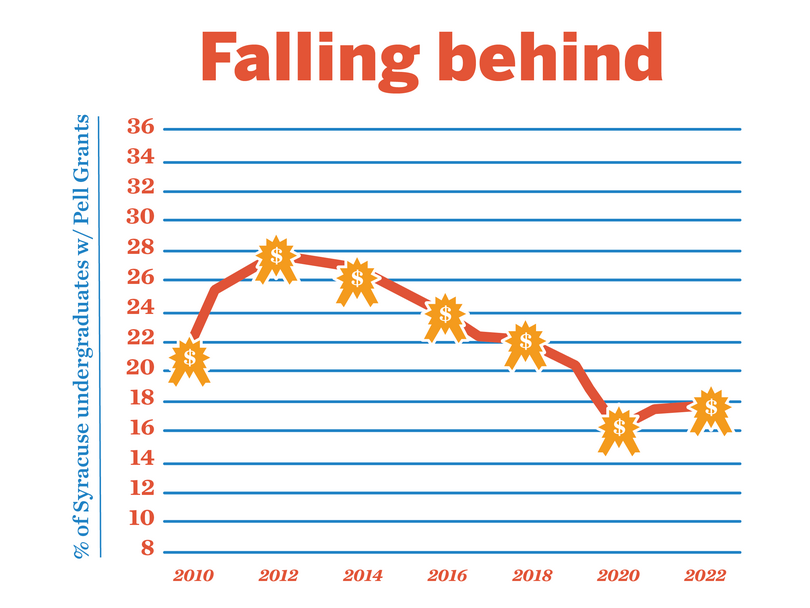PLUMMETING PELL GRANTS: Percentage of SU Undergraduate Pell recipients has decreased over a decade

Bridget Overby | Presentation Director
Since its peak in 2011, the percentage of undergraduate Pell recipients at Syracuse University has decreased by 10 points.
Get the latest Syracuse news delivered right to your inbox.
Subscribe to our newsletter here.
I
n June 2012, a Syracuse University news release emphasized the success of its “aggressive” strategy to increase affordability and economic diversity, highlighting the unprecedented 27% of federal Pell grant-eligible undergraduates that year.
Over a decade later, SU has fallen from being ranked No. 4 among private universities with large endowments in the proportion of undergraduate Pell grant recipients to now sitting below average in the New York Times’s College-Access Index report published in November 2023.
In the College-Access Index — which compiled Pell grant information from the National Center for Education Statistics’ Integrated Postsecondary Education Data System — NYT reported that SU had tied for 166th in economic diversity across “the 286 most-selective colleges in the country.”
From its 27% peak in 2011, the percentage of undergraduate Pell recipients at SU has decreased by 10 points, according to IPEDS data compiled and examined by The Daily Orange. National Pell grant data has also reflected a decline, from 40% in 2011 to 32% in 2021, according to NCES.
SU was an “outlier” compared to other private institutions with similar endowments during its early 2010s peak, said Dr. Sandy Baum, a higher education economist and nonresident senior fellow at the Urban Institute’s Center on Education Data and Policy.
“One of (SU’s) previous presidents made a huge project of increasing the share of low-income students, so the share of Pell grant recipients shot way up very quickly,” Baum said. “Syracuse is really unusual in having made an extreme effort to have socio-economic diversity in the past.”
Throughout her nine-year tenure as SU’s chancellor, Nancy Cantor was a proponent of increasing the affordability of the university and connecting it with the broader city. In 2012, she was one of 10 representatives to promote legislation aiming to improve “clarity in student financial aid packages and college costs” at the White House.
Baum said she believes the decrease over the last decade may be the result of a priority shift in SU’s administration. If the university still maintained its 2011 undergraduate Pell grant recipient percentage of 27%, it would have placed within the top quarter in the country, she said.
“I would expect that since they stopped making that top priority, the share of Pell grants would have gone down,” Baum said.
While the Pell percentage is not an infallible method of describing the economic diversity of a school — as international students and some low-income students do not qualify — it is one of the “only true ways” to estimate the “economic conditions” of a given university, Florida Gulf Coast University Professor Dr. F. King Alexander wrote in a statement to The Daily Orange.
Alexander, who has also served as the president of multiple higher education institutions, wrote the decrease in Pell percentage at SU reflects a “lack of commitment” from the university to prioritize economic diversity over institutional prestige.
“(Syracuse should) recommit to their education and forget US News-type rankings,” Alexander wrote in the statement, referencing the US News and World Report’s “Best National University” list.
“The University works tirelessly to assist all incoming students, not only to meet their financial needs but to also ensure they have the tools and resources they need to be successful in obtaining the appropriate financial support,” an SU spokesperson wrote in a statement to The D.O.
Using IPEDS, The D.O. has compiled SU’s undergraduate Pell grant data from 2009 to 2022 to see how the university compares to both similarly-sized private institutions — Boston University, University of Southern California, Loyola University Chicago, Baylor University and University of Miami — and its central New York neighbors — SUNY Cortland, Le Moyne College, SUNY ESF and Ithaca College.
Explaining Pell
Pell grants are a form of federal financial aid provided by the U.S. Department of Education to students who demonstrate “exceptional financial need,” according to the Federal Student Aid website.
To qualify for Pell, students also must complete the Free Application for Federal Student Aid, or FAFSA.
While the Pell grant program aims to support low-income students, Alexander said the FAFSA form can be a barrier, as only 45% of high school seniors fill it out. In 2020, the FAFSA Simplification Act, which goes into effect for the 2024-2o25 application cycle, aims to increase the number of students who will qualify for the aid.
Dr. Stephen Katsinas, director of the University of Alabama’s Education Policy Center and professor in its College of Education, said the Pell grant has generally been “on the decline” since 2012 — coinciding with reduction to the federal Pell budget.
In order to accurately measure the economic diversity of schools with high endowments, Katsinas said people must consider any gaps between “endowment, any raising of tuition and percentage of students with Pell grants.”
Katsinas said that in contrast with public institutions, private universities like SU rely significantly more heavily on endowments — funds compiled from financial donations to a university — to offer financial aid to lower-income students. The NYT did not classify SU as one of its top “highly-endowed” institutions. For the 2023 fiscal year, SU had a $1.85 billion endowment.
“No one makes the decision to go to Harvard based on getting a Pell grant. They make a decision to go to Harvard based on the financial aid package,” Katsinas said.
The SU spokesperson wrote that the university’s current budget invests a “historic $350 million investment in supporting students” through financial aid, regardless of their “economic means.” This was a 9% increase from the previous budget, they wrote.
“Currently, we meet 96% of demonstrated need with financial aid awards that include Syracuse University scholarships and grants, Federal and State grants, private scholarships and grants, Federal student loans and Federal Work Study,” the spokesperson wrote.
SU and other similarly-sized private institutions
Out of the schools The D.O. analyzed, SU was in the middle of the pack for Pell grant recipient percentages in 2022. However, SU has experienced a sharper decrease within the timeframe than the other six.
Both Baylor and SU peaked around 2011 to 2012, which was before the federal government’s decreased spending on the Pell program.
UMiami and Baylor had a lower percentage of undergraduate Pell grant recipients than SU, having 16% and 14%, respectively. However, UMiami and Baylor had a much less significant decrease from their respective peaks in the undergraduate proportion of Pell recipients.
Out of all the schools The D.O. analyzed, SU and Baylor were the only schools that have continued to trend downward over the past five to seven years.
“Syracuse University just completed an historic admissions cycle in which the University received more applications than ever before,” the university spokesperson wrote. “Despite the headwinds that face us, such as the Supreme Court’s ruling regarding the use of race and ethnicity in admissions and the looming demographic cliff, Syracuse University maintains a commitment to access.”
SU and its neighboring central New York schools
SU’s decrease in Pell recipients also did not reflect its central New York neighbors. All of the schools but SU experienced a relatively consistent Pell grant percentage over the past decade.
In 2022, SU had the lowest percentage of students with a Pell grant out of the five schools The D.O. analyzed. Just under 20% of undergraduates have a Pell grant at Ithaca College, the second lowest percentage among central New York schools The D.O. analyzed.
Typically, public universities like SUNY ESF and Cortland have a greater percentage of Pell grant-eligible undergraduates than private institutions like SU and Ithaca due to several external factors — such as differences in average endowment amounts and state incentive programs, Katsinas said.
Solutions
Several education economics and policy experts — including Baum, Alexander and Katsinas — highlighted several methods to increase economic diversity and equity of admissions. For public universities, Baum and Katsinas recommended state matching programs that incentivize state universities to offer more aid.
The university spokesperson also wrote that the university is working to help students navigate the changes to FAFSA which went into effect during the 2024-2025 application cycle.
This includes helping students navigate the FAFSA Simplification Act, which seeks to streamline the FAFSA process. The implementation of its sweeping changes have brought challenges such as technical glitches and a delay to the rollout of financial aid.
“At Syracuse, we've proactively addressed these challenges head-on by working to adopt the required changes and mitigate any adverse impacts on our student body,” the university spokesperson wrote.
The spokesperson wrote the university is leveraging data from the College Scholarship Service Profile to provide incoming students with estimated financial aid awards to better ensure transparency and clarity throughout the FAFSA application process. They wrote that the university has prioritized communication with current and prospective students regarding financial aid packages and “impending” changes that may affect the packages.
“By taking these proactive measures, we're confident that our timeline for returning students will remain largely unaffected, allowing them to focus on their academic pursuits without undue financial stress,” the university spokesperson wrote.
Baum said another method for increasing access to higher education is improving assistance programs for lower-income K-12 students, which in turn better prepares low-income students for college.
Baum lauded New York state’s Higher Education Opportunity Program, which offers “academic support and financial assistance” programs to students within a certain income bracket, according to SU’s website.
Katsinas said since the country does not fund Pell appropriately, universities need to dedicate more of their budget to promoting equity in admissions.
“The presidents (of universities) are pretty smart people. They’re good at a lot of things, but they don’t know how to print money,” Katsinas said. “If the institution is investing more of its scholarship dollars and need-based aid, they’re probably going to have better results in enrolling low-income students.”
Note: In the dataset, the “year” listed refers to the second half of a given academic year. For example, data from “2009” refers to the 2008-2009 academic year.





